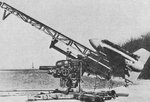delcyros
Tech Sergeant
This really is an issue to cover, Erich!
I wasn´t aware that they used smokeless fuel...
pictures taken from -Märkische Allgemeine Zeitung- 08-11-1997, the author states that EWM W8 and -10 have been used twice in april with success. Not sure if this is true.
I wasn´t aware that they used smokeless fuel...
pictures taken from -Märkische Allgemeine Zeitung- 08-11-1997, the author states that EWM W8 and -10 have been used twice in april with success. Not sure if this is true.


